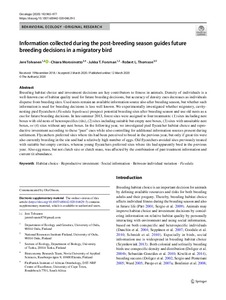Information collected during the post-breeding season guides future breeding decisions in a migratory bird
Chiara Morosinotto; Robert L. Thomson; Jere Tolvanen; Jukka T. Forsman
Information collected during the post-breeding season guides future breeding decisions in a migratory bird
Chiara Morosinotto
Robert L. Thomson
Jere Tolvanen
Jukka T. Forsman
SPRINGER
Julkaisun pysyvä osoite on:
https://urn.fi/URN:NBN:fi-fe2021042823935
https://urn.fi/URN:NBN:fi-fe2021042823935
Tiivistelmä
Breeding habitat choice and investment decisions are key contributors to fitness in animals. Density of individuals is a well-known cue of habitat quality used for future breeding decisions, but accuracy of density cues decreases as individuals disperse from breeding sites. Used nests remain an available information source also after breeding season, but whether such information is used for breeding decisions is less well known. We experimentally investigated whether migratory, cavity-nesting pied flycatchers (Ficedula hypoleuca) prospect potential breeding sites after breeding season and use old nests as a cue for future breeding decisions. In late summer 2013, forest sites were assigned to four treatments: (1) sites including nest boxes with old nests of heterospecifics (tits), (2) sites including suitable but empty nest boxes, (3) sites with unsuitable nest boxes, or (4) sites without any nest boxes. In the following year, we investigated pied flycatcher habitat choice and reproductive investment according to these "past" cues while also controlling for additional information sources present during settlement. Flycatchers preferred sites where tits had been perceived to breed in the previous year, but only if great tits were also currently breeding in the site and had a relatively high number of eggs. Old flycatchers avoided sites previously treated with suitable but empty cavities, whereas young flycatchers preferred sites where tits had apparently bred in the previous year. Also egg mass, but not clutch size or clutch mass, was affected by the combination of past treatment information and current tit abundance.
Kokoelmat
- Rinnakkaistallenteet [19218]
